
Please give generously to Cancer Research : https://www.justgiving.com/Dan-Thompson11/
Date : 5th August, 2017
Time : 1h 0’28”
Total distance run to date : 1150 km
Run map and details : https://connect.garmin.com/modern/activity/1946320964
Australia’s Northern Territory, the Top End. An enormous area of 1 420 970 square km (c 6 times bigger than the UK) that stretches almost 2000 km south from the central part of Australia’s northern coastline to Alice Springs, Uluru and Australia’s Red Centre. And in all that space there’s only 244 000 people. But no shortage of characters as you’ll see later in the blog.
We were in the northern part – the top end of the Top End if you like – and it’s a pretty magical part of the world. Darwin, the capital, isn’t a bad place to start – Mindil beach and its sunset market complete with drum and didgeridoo band (below), Crocosaurus Cove, a great wave lagoon and marine bouncy castle for the kids, the Museum and Art Gallery of the Northern Territory and the empty sands of Casuarina.
And nearby (by Australian standards) are three memorable national parks – Kakadu ; Litchfield and Nitmiluk – with their aboriginal culture, gorges, beautiful (and swimmable) water holes, crocodiles, rock art, look outs and magnetic termite mounds. And it’s not just the natural world that’s enthralling – you’re also going to meet some memorable people.
Take ‘Hamilton’, for example, our guide for a water cruise on the bizarrely named Alligator River. I say bizarrely named because there aren’t any alligators in Australia. But there are crocodiles – masses of them. And they like to congregate at Cahill’s Crossing where, despite all the signs and warnings, they frequently kill and eat people who decide that it’s a good place to fish or ford the river.
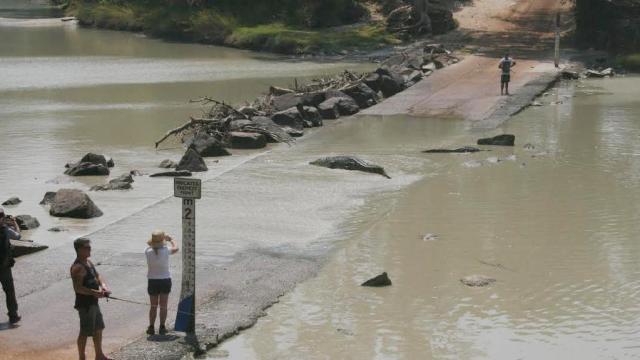
Of course, Alligator River isn’t really its name in any event. Aborigines have lived in the area for approximately 60 000 years and Hamilton was able to give us the name for pretty much everything we saw. (I’d tell you Alligator River’s real name but the local Aborigine language is very hard for Europeans to follow – let alone remember – and Google hasn’t subsequently been able to give me the answer.)
Hamilton also taught us all about the local flora and fauna – much of it eaten as bush tucker ; spear throwing – which is done with a kind of sling which allowed Hamilton to throw the spear hundreds of meters ; and hollering out to ones ancestors. The phrase ‘cultural cruise’ doesn’t always set the pulse racing but this one was brilliant.
And then there are the good citizens of Batchelor.
Batchelor is a (mostly) peaceful town on the edge of Litchfield Park between Katherine and Darwin. We were told that it got its name from a onetime policy of giving land to bachelors in an attempt to make them – and the area – more attractive to women. Wikipedia has a more prosaic version of events involving Lee Batchelor, the minister responsible for the Northern Territory in the early 20th century – but I think I prefer the first story. (When researching this blog I found it unexpectedly difficult to confirm facts about Australia. Even an apparently straightforward query re the size of the Northern Territory produced numerous different answers when I Google searched.)
Batchelor is home to the Batchelor Butterfly Farm – one of the most wonderfully bonkers places you could ever hope to stay in. It has a butterfly house, loads of pick-upable and petable rabbits (mind those hind legs) and a farm full of everything from pigs to goats to turkeys. Best of all, it’s got Chris and Angel and an 80s soundtrack.
On our first night there we found ourselves (ever so appropriately) dancing to Madness and ‘Night Boat to Cairo’ in a couple of pith helmets that Chris had dug out from somewhere. And, no, it wasn’t a surprise that there just happened to be a couple of pith helmets lying around. In fact, it would be hard to name something that Chris and Angel hadn’t used for decoration somewhere on the premises.
“It’s just gone noon,
Half past monsoon
On the banks of the river Nile”

Not all the guests were enjoying themselves as much as we were so, worried that we might be damaging Chris and Angel’s business, we retired to the local Rum Jungle Tavern and their infamous karaoke night. (Rum Jungle being an adjacent area that got its name from an incident when a thief stole 750 ounces of gold – that’s a million dollars’ worth of gold at today’s prices – from miners after getting them drunk with rum.)
At which stage things, if possible, became even more surreal.
At first it all seemed quite clear. The locals were fans of both kinds of music – Country and Western. But then a French woman, subsequently joined by her four children, got up to sing a parody of Vanessa Paradis’s ‘Joe le Taxi’. The de la Trapps then took their applause and disappeared from the tavern – only to reappear twenty minutes later in the kind of conical straw hats that you normally see in the paddy fields of Southeast Asia. Always best, I guess, to be ready for the sort of emergency that requires you to immediately go and plant some rice.
‘Joe le Taxi’ seemed to break the musical shackles and we were treated to an execrable Pink – who singularly failed to get the party started – a (weak) Sonny and (strong) Cher and then a beautiful rendition of ‘Can’t take My Eyes Off You’. Altogether now :
“I love you baby,
And if it’s quite alright,
I only know those two lines
So I’ll la la la the rest”
What’s all this got to do with running? Precious little to be honest – but I wanted to give you a flavour of the Top End. Should you ever decide to go – which I’d wholeheartedly recommend – then make sure you go during the Dry (which happens to coincide with the northern hemisphere summer). Because, if you go during the other season – the Wet -you’ll experience 100% humidity, dawn to dusk sweating and national parks transformed into lakes.
The climate isn’t always ideal for running but, in keeping with Australia’s sporting reputation (despite its relatively small population, it’s the 11th best country in the world at sports) Darwin has plenty of runners. And 3 of them – Amy, Dave and Ian – were good enough to join us for Run the World Australia.
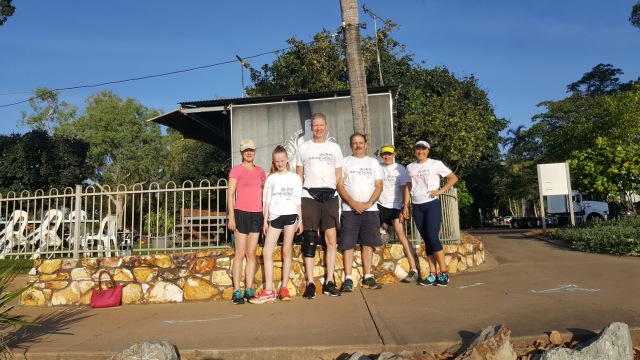
We started at Darwin’s ski club which, when I first heard it mentioned, I assumed was some sort of postmodern ironic comment on the lack of snow in the Top End. However, it does, of course, refer to water skiing rather than alpine skiing. And actually turns out to contain an element of postmodern irony as you can no longer water ski near Darwin due to the number of salties (salt water crocodiles) and stingers (box jellyfish) in the local waters.
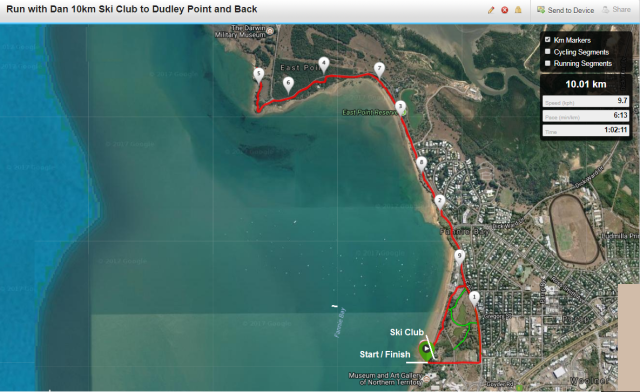
It was a lovely run along the shoreline with the sun setting off to the West. The others took pity on my knee and general lack of fitness and we took it fairly easy. To be fair, I think I may have seen cane toads racing faster than I did that day..
As an aside, for those who have never been cane toad racing, it involves lots of jokes about cane toads with names such as Donald Jump, Jerry Springer, Fat Bastard, Skippy’s Love Child and Camel Toad. And then, much to everyone’s amusement, the ‘jockeys’ have to kiss their toads. The actual racing is fairly incidental to the whole evening. Which is just as well as the toads are generally quite happy to sit there – despite their ‘jockeys’ best efforts with the ‘whips’ (straws for blowing air onto the recalcitrant toads.)
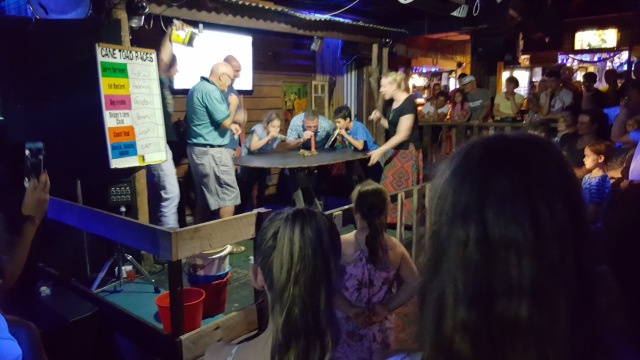
Back to the run, which, while it may have taken over an hour, was perfect for chatting. enjoying the scenery – and for my knee. We even did an extra 500m so that Dave could complete 21 km for the day (his daily training regime…)
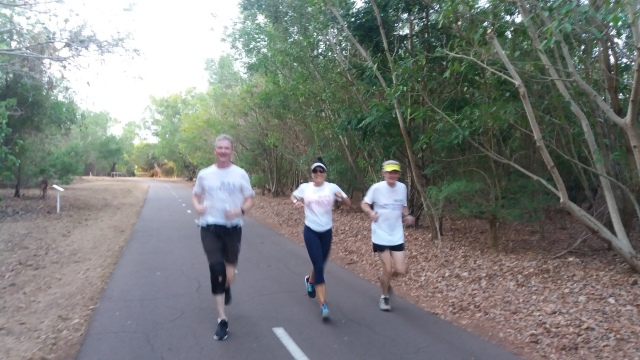
Afterwards at the club, we indulged in that Australian habit of an ice cold stubby or two and swapped war stories. Literally in this case as Dave, Ian and Amy were all ex-military. More of that in the next blog about East Timor.
For now it just remains to thank Ian, Dave, Amy, Chris, Angel, Hilton, the singers at the Rum Jungle Tavern and everyone else who made our run and time in the Top End so memorable.
Facts & Stats
From Wikipedia, the free encyclopaedia.
Australia is a sovereign country comprising the mainland of the Australian continent, the island of Tasmania and numerous smaller islands. It is the largest country in Oceania and the world’s sixth-largest country by total area. The neighbouring countries are Papua New Guinea, Indonesia and East Timor to the north; the Solomon Islands and Vanuatu to the north-east; and New Zealand to the south-east. Australia’s capital is Canberra, and its largest urban area is Sydney.
For about 50,000 years before the first British settlement in the late 18th century, Australia was inhabited by indigenous Australians, who spoke languages classifiable into roughly 250 groups. After the European discovery of the continent by Dutch explorers in 1606, Australia’s eastern half was claimed by Great Britain in 1770 and initially settled through penal transportation to the colony of New South Wales from 26 January 1788. The population grew steadily in subsequent decades, and by the 1850s most of the continent had been explored and an additional five self-governing crown colonies established. On 1 January 1901, the six colonies federated, forming the Commonwealth of Australia. Australia has since maintained a stable liberal democratic political system that functions as a federal parliamentary constitutional monarchy comprising six states and several territories.
Australia has the world’s 13th-largest economy and ninth-highest per capita income (IMF).With the second-highest human development index globally, the country ranks highly in quality of life, health, education, economic freedom, and civil liberties and political rights. Australia is a member of the United Nations, G20, Commonwealth of Nations, ANZUS, Organisation for Economic Co-operation and Development (OECD), World Trade Organization, Asia-Pacific Economic Cooperation, and the Pacific Islands Forum. The population of 25 million is highly urbanised and heavily concentrated on the eastern seaboard. Australia had the world’s 9th largest immigrant population, with immigrants accounting for 26% of the population.
The Northern Territory (abbreviated as NT) is a federal Australian territory in the central and central northern regions of Australia. It shares borders with Western Australia to the west (129th meridian east), South Australia to the south (26th parallel south), and Queensland to the east (138th meridian east). To the north, the territory is bordered by the Timor Sea, the Arafura Sea and the Gulf of Carpentaria. Despite its large area—over 1,349,129 square kilometres (520,902 sq mi), making it the third largest Australian federal division—it is sparsely populated. The Northern Territory’s population of 244,000 (2016) makes it the least populous of Australia’s eight major states and territories, having fewer than half as many people as Tasmania.
The archaeological history of the Northern Territory begins over 40,000 years ago when Indigenous Australians settled the region. Makassan traders began trading with the indigenous people of the Northern Territory for trepang from at least the 18th century onwards. The coast of the territory was first seen by Europeans in the 17th century. The British were the first Europeans to attempt to settle the coastal regions. After three failed attempts to establish a settlement (1824–1828, 1838–1849, and 1864–66), success was achieved in 1869 with the establishment of a settlement at Port Darwin. Today the economy is based on tourism, especially Kakadu National Park in the Top End and the Uluru-Kata Tjuta National Park (Ayers Rock) in central Australia, and mining.
The capital and largest city is Darwin. The population is concentrated in coastal regions and along the Stuart Highway. The other major settlements are (in order of size) Palmerston, Alice Springs, Katherine, Nhulunbuy, and Tennant Creek. Residents of the Northern Territory are often known simply as “Territorians” and fully as “Northern Territorians”, or more informally as “Top Enders” and “Centralians”.
World Bank Data
Here’s the latest World Bank data for Australia – with the year 2000 as a comparison.
GDP $1.21 tn 2016 $415 bn 2000
Population 24.1 m 2016 19.2 m 2000
Primary school enrolment* 102% 2015 100% 2000
% below poverty line** No data
Life expectancy at birth 82.5 yrs 2015 79.2 yrs 2000
GNI per capita $54420 2016 $21130 2000
*Percentage can exceed 100% due to the inclusion of over and under aged students
**The World Bank notes that the methodology can vary between countries and over time within a given country. (While most of the World Bank data generally follows understandable trends, this number often oscillates wildly suggesting that different methodologies are frequently used over time within a given country.)
Greatest Sporting Nation Data
Finally, here’s the data from Greatest Sporting Nation on how Australia performed in the global sporting arena in 2016:
Global Cup – 11th
Per Capita Cup – 11th
The Global Cup aggregates results from over 1000 events across 80 sports to produce the definitive ranking of international sporting success. The Per Capita Cup uses the same data to produce a per capita ranking.

Pingback: Run 116 : East Timor – Dili | dansgoldchallenge